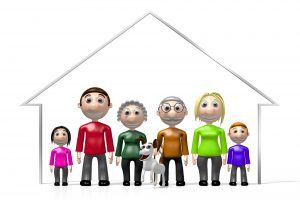
A mother-in-law suite is a separate private living area built within a property. Homeowners can create a mother-in-law suite inside a home, attached to a home, or as a separate unit on the property. Typically, these suites are built for a relative or in-law, which is where they get their name.
Mother-in-law suites were popular in post-WWII America until zoning laws were set in place that slowed construction. However, in recent years, these homes within a home have made a comeback.
What is Considered a Mother-in-Law Suite?
The standard mother-in-law suite contains four parts:
- A living area.
- A bedroom.
- A bathroom.
- A kitchen.
Often, they are attached to the main home but exist as a separate unit. These living arrangements are standard in multigenerational homes, where, for example, a parent lives with a child and their family.
Mother-in-law suites can also be simple, such as a single room with a bed, couch, and an eating area. These units also share a bathroom with the other family members.
Mother-in-law suites are often located in separate parts of a home, such as above a garage or in the basement, and have a separate entrance.
Why are Mother-in-Law Suites Growing in Popularity?
Mother-in-law suites had a resurgence in popularity in the last decade. A 2021 study by Generations United suggests that 1 in 4 Americans live in multigenerational homes, with this number increasing from 7% to 26% since 2011.
Several factors contribute to this growing number.
COVID-19
The COVID-19 pandemic is a driving factor in the increase of multigenerational occupancy.
57% of Americans say they started living together because of the pandemic and continued long term.
Economic Circumstances
66% of families who chose to become a multigenerational home stated that economic factors influenced their decision. Other economic factors that drove families to this type of living arrangement include:
- Eldercare (34%).
- Childcare or child education needs (34%).
- Job loss or change in job status (30%).
- Education and retraining expenses (23%).
Different Types of Mother-in-Law Suites
There are several different types of mother-in-law suites. Each type depends on budget, available space, and personal preferences.
Interior Mother-in-Law Suite
Interior mother-in-law suites are built within the home. These areas can be a converted basement, den, or study. But, the size and makeup of the existing home often dictate what is possible.
Some floor plans allow for separate bathrooms for both generations, with bedrooms at either end of the home. In these scenarios, families share kitchens, dining, and living spaces.
Converted basements commonly have independent living and sleeping quarters, with their own kitchen, bathroom, and a separate entrance.
Attached Mother-in-Law Suite
An attached mother-in-law suite is an independent unit typically connected to the side or back of an existing home.
Detached Mother-in-Law Suite
Detached in-law suites, also known as accessory dwelling units (AUD), are built on the same lot as a single-family residence.
Attic or Garage Mother-in-Law Suite
Attic or garage mother-in-law suites are built by remodeling these spaces into separate areas that contain a kitchen, bedroom, living room, and bathroom.
What to Consider Before Building a Mother-in-Law Suite?
Local codes and ordinances are determining factors in building in-law suites. Therefore, it is essential to review the zoning laws and occupancy codes.
Other considerations are costs. Some remodeling projects can be completed by homeowners, while others will need the help of professionals.
Homeowners need to consider the long-term. For example, detached units can become rental property in the future. However, this requires specific considerations like independent access and separate utilities.
Finally, if an in-law suite is built for eldercare, the construction of the unit will need to be geared toward access and ease of use. These considerations could include wheelchair access, handrails, and zero-curb showers.
Do Mother-in-Law Suites Add Value to the Home?
While in-law suites undoubtedly add value to a property, it can be challenging to quantify the exact numbers because in-law suites come in different shapes and sizes, with various amenities and finishes. Additionally, it can be hard to find a suitable home in the neighborhood to compare prices.
National averages for basement remodels or additional primary suites can give some indication. For example, a basement remodel can add $30,000 to a home, while a primary suite can add $85,000 or more.
Another factor for homeowners to consider is that in-law suites can narrow the appeal of a home should they choose to sell. Independent living areas won’t appeal to every buyer.
However, building attachments to a home ultimately increases the square footage, which increases the value.
Of course, while home value is an essential factor to consider, in-law suites are popular because they can help reduce eldercare or childcare costs. In addition, homeowners can offset these costs against the price of construction or renovation.
Marimark Realty
Marimark Realty’s real estate agents focus on providing a personalized experience for buyers and sellers of real estate. As a full-service real estate agency, we help clients with luxury homes, homes for first-time homebuyers, commercial property, and investment property.
To begin the journey of purchasing or selling your home, or purchasing commercial or investment properties, contact us at your earliest convenience.
